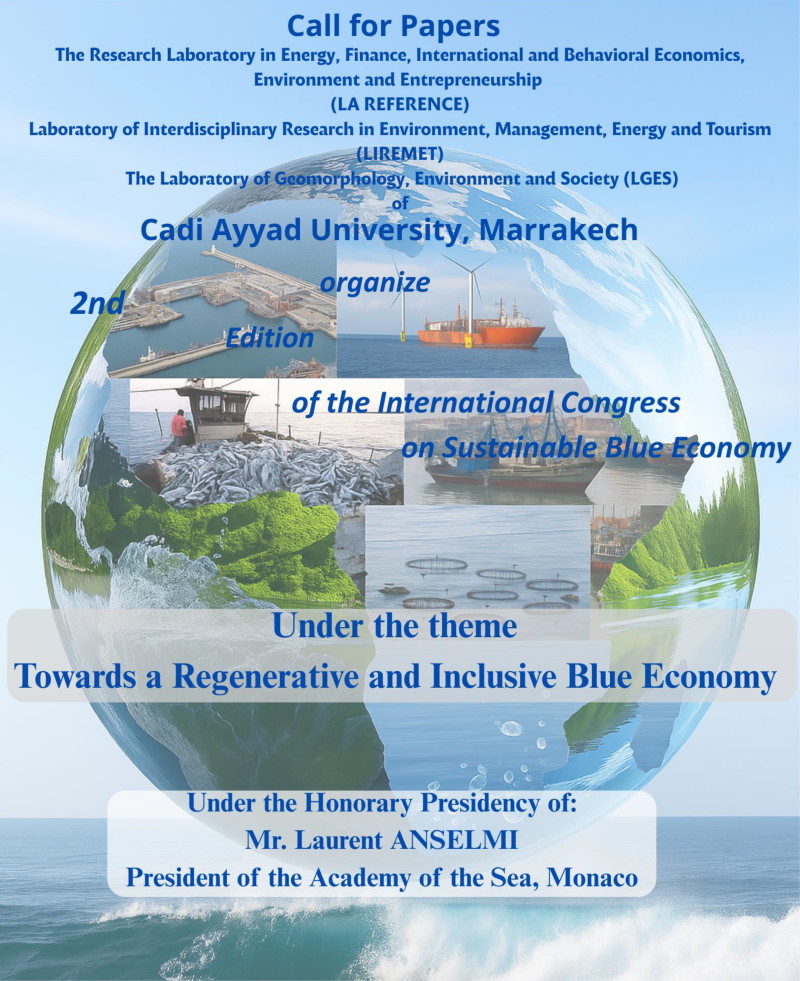O diferencial de tributação em Marrocos
uma análise econométrica do impacto dos fatores sociodemográficos e fiscais
DOI:
https://doi.org/10.23882/emss.24208Palavras-chave:
gap fiscal, évasion fiscale, évitement fiscal, facteurs socio-démographiques, variables fiscalesResumo
Este estudo visa apreender o impacto de variáveis não económicas no hiato fiscal em Marrocos, nomeadamente os factores sociodemográficos e fiscais (alterações regulamentares). A análise é feita para o período 1980-2018 e inclui variáveis de controlo económicas. Para o efeito, estimamos um modelo log-linear utilizando o método dos mínimos quadrados modificados.
Os resultados lançam luz sobre o efeito das variáveis sociodemográficas na evolução do diferencial de tributação em Marrocos: a idade parece refletir o efeito da experiência em contornar a tributação. O género e a educação não parecem ter qualquer efeito sobre o diferencial de tributação em Marrocos. O impacto das variáveis de controlo económico parece claro: os rendimentos/lucros gerados no sector do comércio parecem estar sujeitos a evasão/evasão fiscal e, consequentemente, aumentam o diferencial de tributação em Marrocos, em comparação com os rendimentos gerados por outros sectores. Os factores fiscais foram introduzidos nas nossas estimativas através de variáveis fictícias. Estes permitiram-nos concluir que os agentes económicos são mais sensíveis a medidas e regulamentos fiscais indirectos do que a medidas directas destinadas a reduzir o diferencial de tributação.
Referências
Allingham, Michael G., & Sandmo, A. (1972). “Income Tax Evasion: A Theoretical Analy- sis.” Journal of Public Economics 1 No. ¾, pages 323-38.
Arby, M. F., Malik, M. J., & Hanif, M. N. (2012). “The size of informal economy in Pakistan”, Finance Research, 1(2), pages 11-18.
Bühn, A., & Schneider, F. (2008). « MIMIC Models, Cointegration and Error Correction: An Application to the French Shadow Economy», CESIFO Working Paper N° 2200, Category: Public Finance.
Cagan, P. (1958). “The Demand for Currency Relative to Total Money Supply”, National Bureau of Economic Research, New York, Occasional Paper 62.
Christian, C. W., & Gupta, S. (1993). “New evidence on ‘secondary evasion’”, Journal of the American Taxation Association, 16, pp: 72–93.
Clotfelter, C. T. (1983). “Tax Evasion and Tax Rates: An Analysis of Individual Returns”. The Review of Economics and Statistics, The MIT Press, 65(3), 363-373.
Dell’Anno, R., & Solomon, O. H. (2008). « Shadow Economy and Unemployment Rate in USA: Is there a Structural Relationship? An Empirical Analysis », Applied Economics, 40(19), 2537-2555.
Dubin, J., & Wilde, L. (1988). “An Empirical Analysis of Federal Income Tax Auditing and Compliance”. National Tax Journal, 1988, 41(1), 61-74.
El Aida, K., & Fettahi, I. (2018). « Estimation de la taille de l’économie non observée au Maroc et analyse de son évolution : utilisation de la méthode de demande de monnaie », article non publié.
Engle, R. F., & Granger, C. W. J. (1987). « Co-integration and error correction: representation, estimation, and testing», Econometrica: Journal of the Econometric Society, 55(2), 251-276.
Feige, E. L. (1979). « How big is the irregular economy? », Challenge, 22(5), 5-13.
Feinstein, J. S. (1991). “An econometric analysis of income tax evasion and its detection”, RAND Journal of Economics, 22, 14–35.
Feld, L., &Schneider, F. (2010). « Survey on the Shadow Economy and Undeclared Earnings in OECD Countries », German Economic Review, 11(2), 109-149.
Guttman, P. M. (1977). « The subterranean economy », Financial Analysts Journal, 33(6), 26-27.
Hanno, D. M., & Violette, G. R. (1996). “An analysis of moral and social influences on tax behavior”, Behavioral Research in Accounting, 8, 57–75.
Jackson, B. R., & Milliron, V. C. (1986). “Tax compliance research: Findings, problems and prospects”, Journal of Accounting Literature, 5, 125–165.
Kelley, B. (1994). « The Informal Sector and the Macroeconomy: A Computable General Equilibrium Approach for Peru », World Development, 22(9), 1393-1411.
Mason, R., & Calvin, L. (1984). “Public confidence and admitted tax evasion” National Tax Journal, 37(4), 489-496.
Mason, R., & Lowry, H. (1981). “An estimate of income tax evasion in Oregon”, Working Paper, Corvallis, Oregon: Survey Research Center, Oregon State University.
Mason, R., &Calvin, L. (1978). “A study of admitted income tax evasion”, Law and Society Review, 12, 73–89.
Murray, M. P. (1994). « A Drunk and Her Dog : An Illustration of Cointegration and Error Correction», The American Statistician, 48(1), 37-39.
Phillips, P. C. (1992). « Hyper-consistent Estimation of a Unit Root in a Time Series Regression ». Cowles Foundation for Research in Economics at Yale University, Discussion Paper N°1040.
Phillips, P. C. (1995). « Fully modified least squares and vector autoregression », 63(5), Econometrica: Journal of the Econometric Society, 1023-1078.
Phillips, P. C., & Hansen, B. E. (1990). « Statistical inference in instrumental variables regression with I (1) processes. » The Review of Economic Studies, 57(1), 99-125.
Richardson G. (2006)- “Determinants of tax evasion: A cross-country investigation”, Journal of International Accounting, Auditing and Taxation, 15, 150–169.
Richardson, M., & Sawyer, A. J. (2001). “A taxonomy of the tax compliance literature: Further findings, problems and prospects”, Australian Tax Forum, 16, 137–320.
Sandmo, A. (2005). « The Theory of Tax Evasion: A Retrospective View », National Tax Journal, 58(4), 643-663
Schmolders, G. (1970). “Survey research in public finance: A behavioral approach to fiscal theory”, Public Finance, 25, 300–306.
Schneider, F., Buehn, A., & Montenegro, C. E. (2010). « Shadow Economies all over the World: New Estimates for 162 Countries from 1999 to 2007 », World Bank Policy Research Working Paper Series, WP S5356.
Song, Y. D., & Yarbrough, T. E. (1978). “Tax ethics and tax attitudes: A survey”, Public Administration Review, 38, 442–452
Tanzi, V. (1980). « The Underground Economy in United States–Estimates and Implications », BancaNazionale de Lavoro Quarterly Review, 135, 427-453.
Tanzi, V. (1983). « The Underground Economy in the United States: Annual Estimates, 1930-80», Staff Papers-International Monetary Fund, 30(2), 283-305.
Tittle, C. (1980). “Sanctions and social deviance: The question of deterrence”, New York: Praeger.
Vogel, J. (1974). “Taxation and public opinion in Sweden: An interpretation of recent survey data”, National Tax Journal, 27, 499–513.
Wallschutzky, I. G. (1984). “Possible causes of tax evasion”, Journal of Economic Psychology, 5, 371–384.
Warren, N. (2018). “Estimating Tax Gap is everything to an informed response to the Digital Era”, Working paper, UNSW Business School Taxation and Business Law, Australia’s Global University.
Witte, A. D., & Woodbury, D. F. (1985). “The effect of tax laws and tax administration on tax compliance: The case of the U.S. individual income tax”, National Tax Journal, 38, 1–13.
Downloads
Publicado
Como Citar
Edição
Secção
Licença
Direitos de Autor (c) 2024 El Aida Kawtar, Fettahi Ithri

Este trabalho encontra-se publicado com a Creative Commons Atribuição-NãoComercial 4.0.









